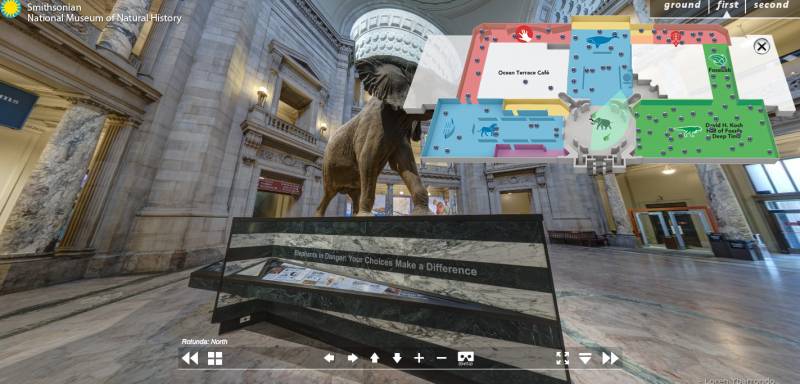Curator's Note
To view a tour of the Smithsonian National Museum of Natural History, Click Here!
The Smithsonian Museums are the “official” museums of the United States. They are funded by tax dollars and have a prominent place on the National Mall. During this time of social distancing due to Covid-19, museums have had to place more emphasis on virtual tours. With museums playing a large role in public memory, this new emphasis creates issues for the meaning that is rooted in place. However, there are positives to an expansion and promotion of virtual tours, mainly being greater access for the public and a more interpretive idea of meaning from the less guided construct of the institution created by the physical space.
Visiting the Smithsonian Museums and the National Mall in Washington D.C. is a chance to understand the societal and political public memory our nation tries to convey to its peoples. As noted by Atwater and Herndon, “the physical location of a museum produces a powerful message” (15). The Smithsonian Museums’ location of the U.S. capital conveys a sense of authority and authenticity. In other words, these museums’ locations are provided a type of gravitas that lends official legitimacy of meaning for the residents of the U.S., whatever that may be for each individual. As the pandemic has restricted our ability to physically visit these museums, the power of their material location is diminished. For virtual tour-goers, the power of place and authority created by these museums being located in the nation’s capital is lost.
On the other hand, there are positives from allowing virtual tours, including ease of access and enhanced autonomy to form individual views of public memory. More and more people will have access to see the museums, regardless of their physical distance from the capital, which will at least allow some form of public memory to take shape. Will the issue of physical immediacy impact meaning? Probably, but by how much? We know that online public memory allows for the creation of meaning (Hess 816). Virtual tours could allow for more focus on the material objects presented for memory, because there is a less guided interpretation from the museum. This is happening because the Smithsonian’s placards that offer description can be challenging to see online. Without access to that information, people will be able to form their own interpretation of what they are seeing and define importance and meaning in their own way. Thus, the role of public memory and power of artifacts may change because of the role of place and access.
Atwater, Deborah and Sandra Herndon. “Cultural Space and Race: The National Civil Right Museum and Museum Africa.” Howard Journal of Communication, vol. 14, No. 1, 2003, pp. 15-28.
Hess, Aaron. “In Digital Remembrance: Vernacular Memory and the Rhetorical Construction of Web Memorials.” Media, Culture, and Society, vol. 29, no. 5, 2007, pp. 812-830.

Comments
Being submerged
Thanks for writing this piece, I actually hadn't tried any of the virtual tours until I read this. I do love the access issue, having struggled obtain tickets for the "hottest" DC museums in recent years. There's no doubt there are benefits to this move online. At the same time, I'm wondering if there will ever be a way to replicate the emotional experiences that come along with visits to the physical museums. You mention the importance of space and I think you are also referencing that part of the physical visit experience. Even though museum crowds can be annoying (my last visit to the Holocaust museum happened alongside school visits with middle school punks wearing MAGA hats), there is something about "containing" the visit into a space that controls the flow of the crowd (to some extent), the noise, the seating, the smells, the temperature, the lighting, etc. If done well, all of it seems to submerge you into the subject and when you walk outside of the building, it seems as if you've been changed in some way.
Add new comment